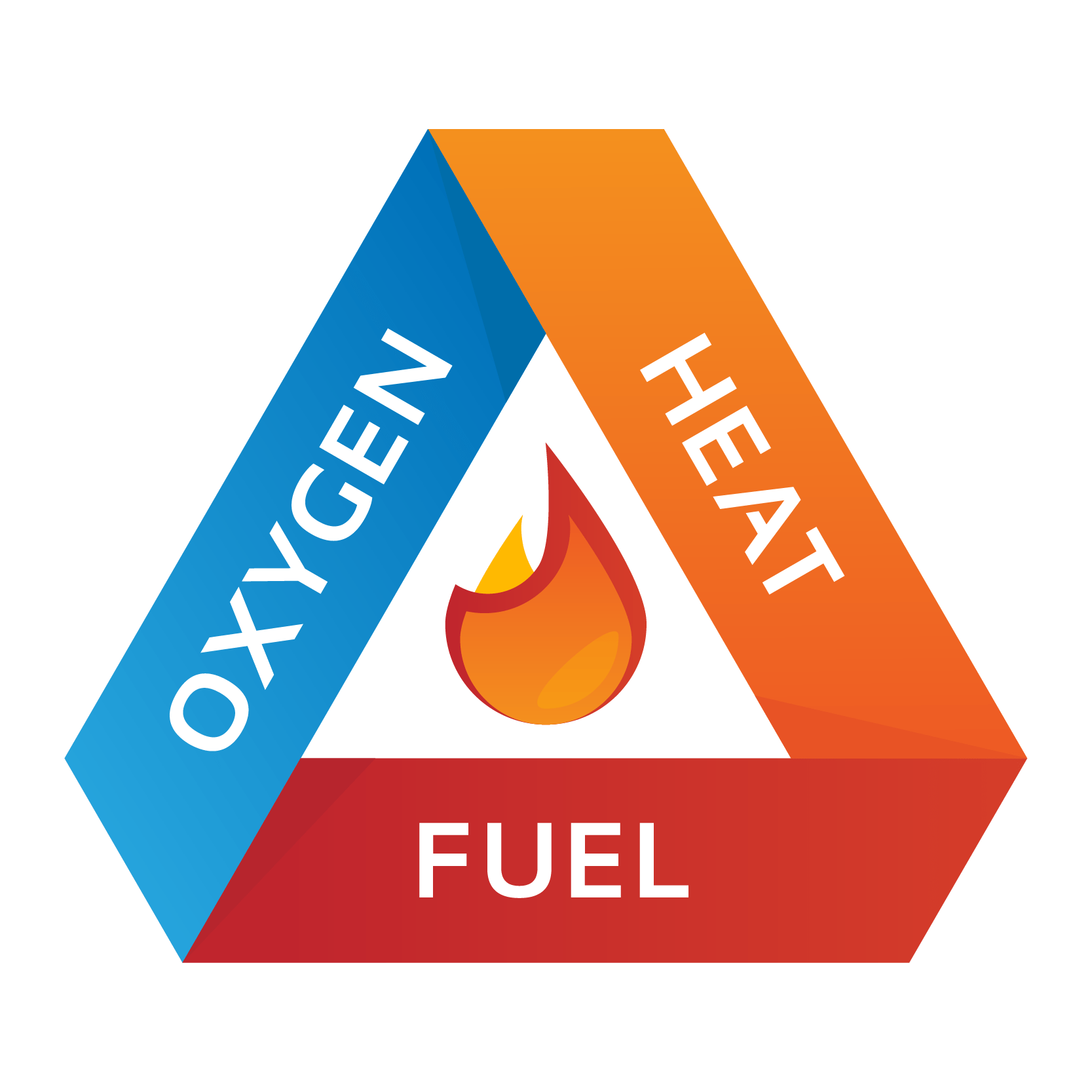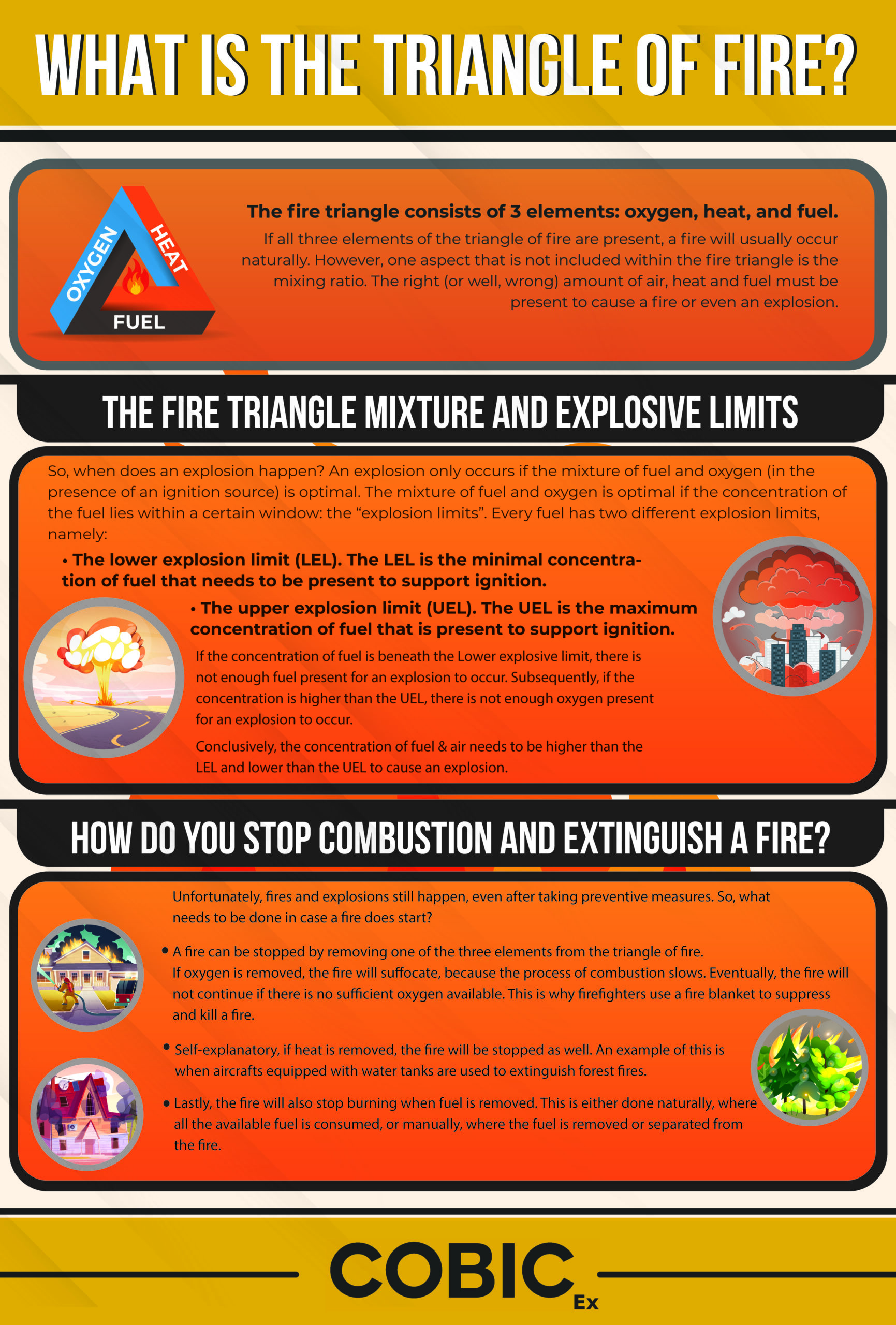Perhaps you have heard of it before, the fire triangle. The triangle of fire is well known and essential in many industries and contexts, for instance, ATEX. Did you know that the fire triangle has many synonyms and variants, like the combustion and explosion triangle? Next to that, there is also a “fire tetrahedron,” which consists of more parts than the fire triangle and is a little more complex. In this blog, Cobic-ex will handle different topics and questions regarding this subject, such as: what is the fire triangle? And what are the three elements of the fire triangle?
What is the triangle of fire?
The fire triangle consists of 3 elements: oxygen, heat, and fuel. This model of the three aspects of fire is designed to understand the ingredients necessary for most fires. If all three components of the triangle of fire are present, a fire usually occurs naturally. However, a critical aspect of the fire triangle is not included in the mixture of the components. A specific mix of the three fire triangle components must be present to support fire or even an explosion. This mixing ratio is essential when it comes to whether a fire occurs. Subsequently, we come to the question regarding the difference between fire and explosions.

The fire triangle and the explosion triangle
The fire and the explosion triangle have the same components but differ in one aspect: the burning rate. The main difference between fire and explosions is that an explosion occurs at a much faster burning rate than a fire. In addition, a fire can lead to an explosion, and an explosion can also lead to a fire.
The fire triangle mixture and explosive limits
The last paragraph mentioned the importance of the mixing ratio for a fire to occur. This mixing rate is even more critical for explosions to occur. Essential elements for outbreaks to occur are fuel and oxygen. An explosion only occurs if the mixture of fuel and oxygen (in the presence of an ignition source) is optimal. The mix of fuel and oxygen is optimal if the concentration of the fuel lies within a specific window: the “explosion limits.” Every flammable substance has two different explosion limits, namely:
- The lower explosion limit (LEL). The LEL is the minimal concentration of fuel that needs to be present to support ignition.
- The upper explosion limit (UEL). The UEL is the maximum fuel concentration present to support ignition.
If the fuel concentration is beneath the Lower explosive limit, there is not enough fuel present for an explosion. Subsequently, if the concentration is higher than the UEL, there is not enough oxygen for an explosion. Conclusively, the fuel concentration must be within a specific window to cause an explosion.
Going over the explosive limit to prevent an explosive atmosphere is usually not very practical. Imagine pumping a room full of dust just to go over the UEL. This is why manufacturers aim to stay under the LEL through high-level cleaning.
How do you stop combustion and extinguish a fire?
When it comes to safety, preventing fire and explosions are fundamental aspects. The occurrence of fire and explosions can be prevented by taking measures, like the purchase of explosion proof equipment. Unfortunately, a fire could always start, even after taking preventive measures. So, what needs to be done in case a fire does start?
A fire can be stopped by removing one of the three elements from the triangle of fire.
For example, firefighters use a fire blanket to suppress and kill a fire. If oxygen is removed, the fire will suffocate because combustion slows. Eventually, the fire will not continue if insufficient oxygen is unavailable.
Self-explanatory, if heat is removed, the fire will stop as well. An example is an aircraft equipped with water tanks to extinguish forest fires.
Thirdly, the fire will also stop burning when fuel is removed. This is done naturally, where all the available fuel is consumed, or manually, where the fuel is removed or separated from the fire.
What is the fire triangle infographic

The fire tetrahedron
The fire tetrahedron originated from additional research and is an extended version of the fire triangle. This fire tetrahedron can best be described as a pyramid with four instead of three elements. The fourth element that is added to the fire triangle is a chemical chain reaction because a chemical chain reaction initiates when something catches fire. This reaction also allows the fire to continue until or unless one of the fire triangle components is blocked.
The Fire triangle and tetrahedron might seem like simplistic models, but they are vital for preventing a fire from occurring and extinguishing fires.
We hope you have learned more about subjects such as the triangle of fire, the explosion triangle, and how a fire can be extinguished. For more information or questions regarding fire, explosions, intrinsic safety, and ATEX, please don’t hesitate to contact us at info@cobic-ex.com.




